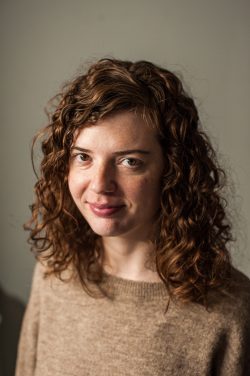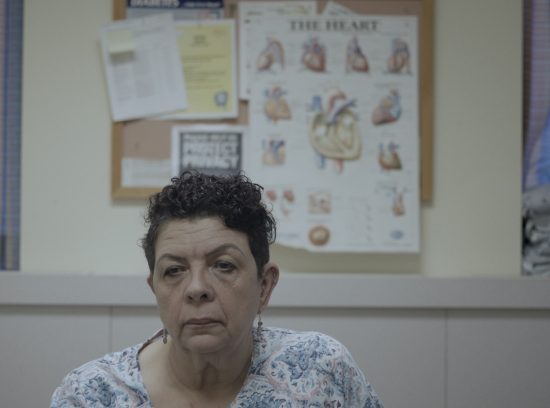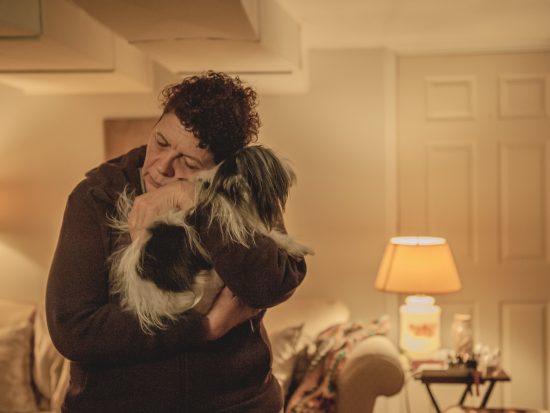TIFF 2019: Director Heather Young on her First Feature Film, Murmur
 “It’s a bit overwhelming at times,” says director Heather Young, speaking on the phone from Halifax a few weeks prior to the premiere of her debut feature at the Toronto International Film Festival. She’s not a stranger to the fest itself, with one of her short films, Milk, playing here in 2017, but bringing her first full length film definitely comes with more attention, especially for a film like Murmur.
“It’s a bit overwhelming at times,” says director Heather Young, speaking on the phone from Halifax a few weeks prior to the premiere of her debut feature at the Toronto International Film Festival. She’s not a stranger to the fest itself, with one of her short films, Milk, playing here in 2017, but bringing her first full length film definitely comes with more attention, especially for a film like Murmur.
Murmur tells the story of Donna (played by Shan MacDonald), a woman who is placed at an animal shelter for community service work after an alcohol related conviction. She adopts an elderly, ill animal named Charlie she finds an emotional connection that she’s been looking for, but ends up taking it to extremes. As the writer-director Young tells it, “There’s this lonely woman who’s longing for connection and longing for love and companionship and tries to get that through acquiring pets but is never quite satisfied.” In essence Donna replaces one addiction for another.
Young’s approach to exploring addition is unique, marrying genres through a documentary style narrative. The premise for Murmur actually grew from a short film that Young made in 2014, Howard and Jean, created as a fiction/documentary hybrid and based on a story about her mother’s relationship with her Chihuahua, Howard. This experience gave her the confidence to explore developing a longer feature; as Young explains, ”A woman kind of isolates herself and relies entirely on her small dog for her companionship and for her social outlet. So after that film, I started thinking what if I kind of took that idea further?”
The daunting task of transitioning from a short film to a feature wasn’t lost on the director, knowing that she had to fill eighty minutes as opposed to ten was at times intimidating. So she aimed to play it smart. “I figured that with my first feature I wanted to kind of take the things that were working for me in my shorts then kind of transfer that to the feature,” Heather said. “I didn’t want to start something brand new because I think going from short to features is challenging enough and I wanted to give myself the most advantage that I could.”
Check out all of our TIFF coverageSpecifically, one of the biggest challenges she had was in editing the film, which she also did herself. It’s not just the minutes you fill on screen, but the number of days you need to shoot in order to get there. “It was just a really large leap to go from the amount of footage that you have when you shoot a short film for a couple of days and then the amount of footage that I had to deal with editing the feature,” Heather explained. “We shot for 25 days and that’s a lot more than what I’m used to shooting for shorts. So just the sheer amount of footage that I had to wade through to do the edit I found quite overwhelming. And there were times when I felt almost helpless.” Once assembly was complete Heather notes that ,”I was able to actually feel like I was editing whereas before I was just kind of drowning.” For her first feature, Young managed to get her mountainous volume of footage down to just shy of 83 minutes, including plenty of quiet, contemplative moments for the audience. At a time when films seem to only be getting longer, it is a refreshing change.As she was working in a documentary style narrative, Young also made the decision, to work with non-professional actors. She found her lead actress during one of her early part time jobs working in a doggy daycare. Shan MacDonald was a client and when Heather was trying to cast her vision, she reached out to her on Facebook. Young explains, ”When we were doing auditions for Murmur I really wanted someone who had a genuine connection to animals and had a genuine and very real kind of love for animals.” MacDonald auditioned and won the part. Many of the roles are played by professionals in their own rights, a veterinarian, cardiologist and addiction counsellor were all cast to play themselves. In this way, the style of film plays more authentic but also lends to some specific challenges.
As Young explains, working with non-professional performers means that her focus is trying to have them, in essence, not act at all. “The kind of main difference in my approach with non-professionals is that I do an unscripted dialogue. So basically that just means that none of the performers in my film were given lines or even given a script,” she says. In this way, the film’s dialogue does seem completely natural, and is less intimidating for those in the film itself as they use their own words and don’t have to memorize lines. Heather notes, “I’m just trying to get them to be themselves and to not try to be anyone else or try to act like someone else. They’re just being who they are naturally in their everyday life.”
The director also had plenty of four-legged performers who were on set adding to some anxiety for her. While she had used animals before in her shorts, it was never to this extent. Speaking about it, and with her own personal experience with animals, it’s easily palpable how important it was to Heather to make sure each animal also had a positive experience on set. This added stress paid off with some beautiful shots in the film that clearly portray the importance of the human-animal bond. Says the director, “That’s the thing that I love about working with animals is you can’t predict what they’re going to do. So that lends that kind of unpredictability, it lends a certain anxiety to the set, but it also allows you to have this kind of unexpected discoveries that wouldn’t have happened otherwise.”
In Murmur, the protagonist Donna discovers her deep, emotional connection to animals but also has a distinct physical one with her first adopted dog, Charlie in that they both suffer from an actual heart murmur. In medicine, a murmur is defined as a turbulence in blood flow through the heart. The title of the film alludes not only to the murmur that Donna and Charlie have in common but to the emotional turbulence Donna suffers from also. Heather says, “In addition to it being a heart murmur the word murmur also means mumbling or speaking and not being heard or speaking and not being understood. So I think that kind of applies to Donna as well because she’s trying to make these connections with people and she’s not successful, she’s not being understood when she tries to communicate with people. So that was kind of the double meaning there of the word so I thought it fit pretty well.”
Donna’s story was an important one for Young to tell and her main hope is that the audience feels empathy for her main character. She truly hopes they will come away without judgement, especially as Donna is a woman in her 60s, a rarity on screen in cinema. “I think we hardly ever see that and that has to do with a whole variety of factors but one of them being that in our society women are not really valued when they’re like over the age of 25,” Young explains. “To a certain extent, women tend to lose their value in society as they age, or at least that’s how it could be perceived so it was important to me to give this focus and time to an older female character because it’s such a rare thing.” The director continued to say,”It would be great for me especially if older women saw the film and saw that attention, focus, and respect was being given to an older female character that it would make them feel seen or make them feel acknowledged in some way – that would be really great.”
With more women telling their stories, we are more apt to see journeys like Donna’s on the big screen. It’s a far cry from when Heather Young was the only woman in her film studies class which, she notes, already, “Makes you feel isolated and makes you feel like you don’t belong.” However, she sees improvement in the industry despite a history of inequality. “ I think the biggest [challenge] is just doubting myself…. I’ve noticed that more in female filmmakers in general I think,” Heather says.” When it comes to her place in filmmaking she notes it can be difficult as you can have conflicting thoughts about “Believing that you belong in this industry or just doubting all your decisions and doubting whether or not whether you’re worthy or good enough to be a director. I don’t see that as much in men…Within a patriarchal society it’s kind of hard not to ingest that.” That self doubt is something, she notes, not unique just within the film industry itself.
With her feature film debuting on September 6th, hopefully some of Heather Young’s self doubt as a director will be erased. Donna’s story is exactly what she wants it to be, an empathetic portrait of a woman reaching out, of someone desperate to connect. As a brave new voice in cinematic features Young’s unique style will set her apart as a Canadian director to watch. With TIFF’s Share Her Journey initiative highlighting excellence in film by women, Murmur becomes an important, home-grown addition. Young may need to get used to the added attention.
Next PostPrevious Postkofiwidget2.init(‘Buy Live for Films a coffee’, ‘#46b798’, ‘O5O5MLYA’);kofiwidget2.draw();(adsbygoogle = window.adsbygoogle || []).push({});











